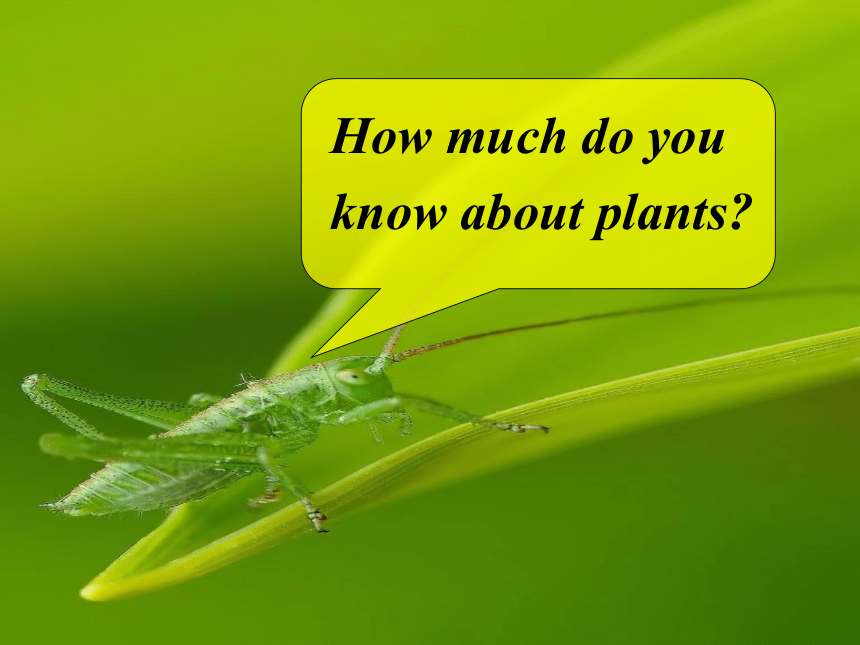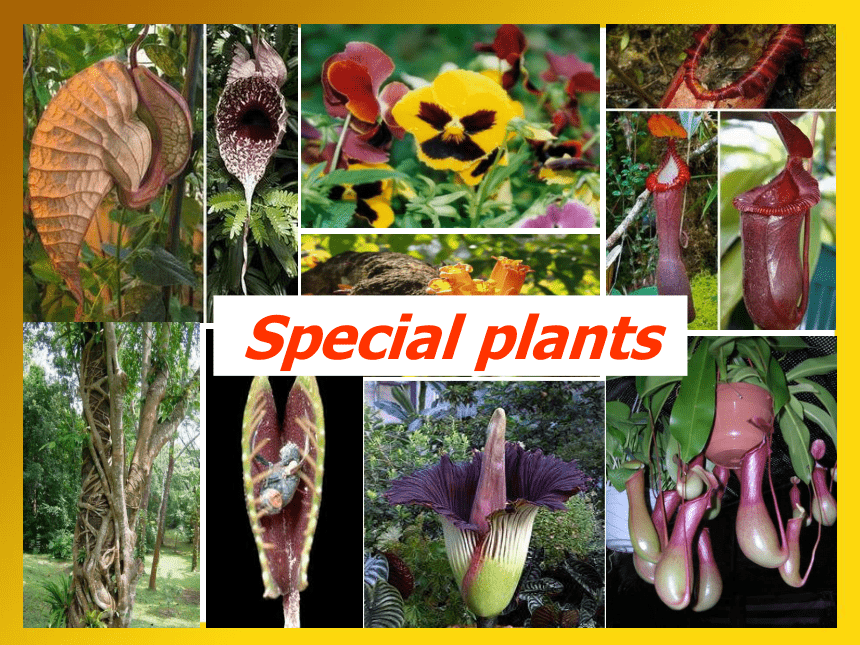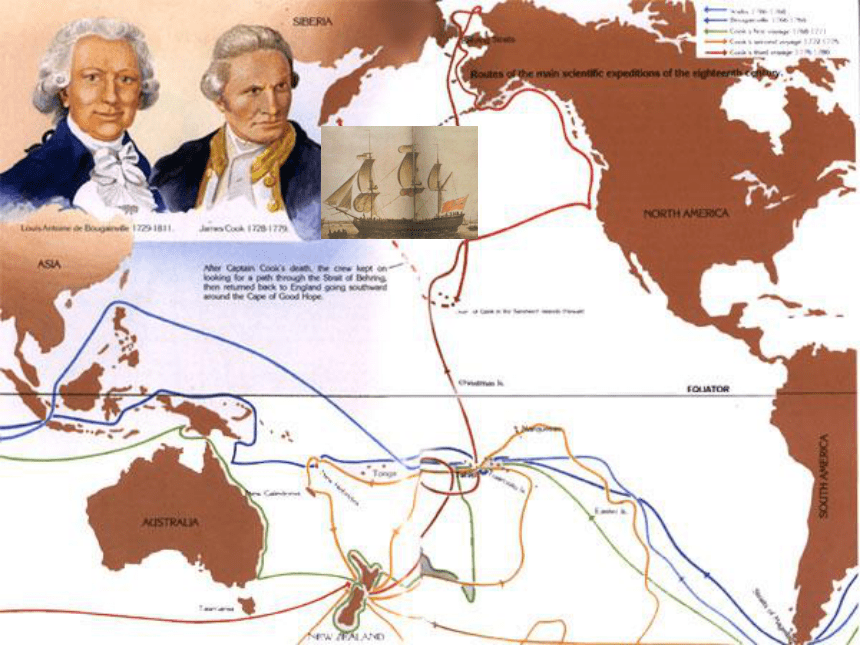Unit4 Exploring planets Warming up and reading课件(55张)
文档属性
| 名称 | Unit4 Exploring planets Warming up and reading课件(55张) |  | |
| 格式 | zip | ||
| 文件大小 | 8.3MB | ||
| 资源类型 | 教案 | ||
| 版本资源 | 人教版(新课程标准) | ||
| 科目 | 英语 | ||
| 更新时间 | 2018-08-03 17:21:51 | ||
图片预览












文档简介
课件55张PPT。Unit 4
Exploring plantsReadingWarming UpPre-readingReadingHomeworkSkimmingScanningDetailed readingWarming upDid you know that:1. some plants do not have flowers?2. some plants have roots that live in
the air?3. some plants eat meat?4. some plants need animals to
pollinate them?5. some plants grow on other plants?6. plants are adapted to live in
specific environments?7. people buy plants that come from
other countries for their gardens?8. a new plant does not always
grow from a seed?Special plantsPre-readingDo you have a courtyard or some pot plants on your balcony? Do you know where these plants come from? Are they Chinese plants or do they come from another country?When you last visited a public garden, did you look at the individual plants
there? Were there any plants from other countries?Dr Nathaniel WardThe Wardian caseRobert Fortune (1812-1880)
represented the Horticultural Society of London (now the Royal Horticultural Society) as a collector in China shortly after the Treaty of Nanjing had brought the Opium War to a close. Through his use of the Wardian case, Fortune was able to introduce many of the best-known Chinese garden plants into cultivation in Europe and North America. Père Paul Guillaume Farges (1844 - 1912) French missionary and naturalist. Born at Monclar-de-Quercy, Tarn-et-Garonne. He was sent to China in 1867 and remained stationed in north-east Sichuan until 1903. Although he had always nurtured an interest in the local flora and fauna, it was not until 1892 that he started to collect herbarium specimens in earnest. During the eleven years before he moved south to Chongqing, he collected and preserved over 4, 000 specimens. Dove TreeErnest Henry Wilson (1876 - 1930) ReadingScan the title of the reading passage and the pictures and predict what it is about?Plant Exploration in the
18th and 19th centuriesSkimming the beginningWhen: Not until the eighteenth
and nineteenth centuriesWho:European middle classesEuropean nationsWhat:Taking great interest in
collecting plantsWhen:By the middle of the 18th centuryWho:French Catholic missionariesWhat:Father d’Incarville was sent to _______ to ________ _____ of trees and bushes including those of the _____ __ _______Beijingcollected seedsTree of HeavenResult:Seeds of the tree of Heaven were sent to ________, and were grown __________ _______. In 1784, It was __________ in
______ ________. England throughout EuropeintroducedNorth AmericaWhen:In 1769Who:Sir Joseph BanksWhat:Banks ________ ___ of plants none of which had been recorded by __________.collected lotsEuropeans A changeWhen: nineteenth centuriesWho:Dr Nathaniel WardWhat:The invention of
_____________Wardian caseResult:In 1833, ward _______ two cases of British plants to Australia all the plant _____________________ journey. shippedsurvivedthe six--monthWhen:between 1843 and 1859Who:Robert FortuneWhat:He not only introduce ____ ______________ to _______ _______ but he also shipped _____ ___ from _________ to _____.Then120species of plantswesterngardenShanghaiIndiatea plantsWhen:The second half of nineteenth centuryWho:Father FargesWhat:He collected the seeds of ____ ____ and brought them to ______.Dove TreeFranceWhen:1899Who:E H WilsonWhat:He introduced many new plants to ______________.At lastWestern gardenScanning The plants in our garden grew in
China originally.F2. The American Middle Classes took
great interest in collecting new
plants during the 18th and 19th
centuries.F3. French Catholic missionaries were
beginning to set themselves up in
China by the middle of the 18th
century.4. After Father d’Incarville died, some
Tree of Heaven seeds were sent to
England.FBanks, together with James Cook, collected many examples of plants in Australia.6. Keeping plants alive during long
land or sea voyage was very
difficult, which caused the
Wardian Case to be invented.7. Robert Fortune introduced over 120
species of plants to Western Gardens,
because he could easily travel
everywhere in China.8. During the second half of the 19th
century, many Catholic missionaries
were sent to China, and they collected
many seeds of plants, which were sent
back to France.FDetailed readingRead the text carefully and match each person to the thing he did.
1. Father d’Incarville
2. Sir Joseph Banks
3. Dr Nathaniel Ward
4. Father Farges
5. Robert Fortune
6. E H Wilson collected lots of seeds of the Dove Tree
sent Tree of Heaven seeds to England
sent the seeds of the Dove Tree back to France
shipped two cases of British plants to Sydney
shipped 20,000 tea plants to India
collected vast quantities of plants in AustraliaAnswers: b, f, d, c, e, aTry to get the main idea of each paragraph.Para 1:explains when plant collecting began.Para 2:describes when and where plant collecting began on a large scale by Europeans.Para 3: talks about French Catholic missionaries who collected plants in China in the 18th century.Para 4:is about the famous British plant collector, Sir Joseph Banks, who collected many new plants in Australia.Para 5: explains the problems of keeping plants alive on long trips.Para 6:describes an experiment carried out by Dr Nathaniel Ward who invented a glass case in which to transport plants on long journeys.Para 8:is about Father Farges, a French Catholic missionary who collected plants in China in the 19th century.Para 7: is about Robert Fortune, a British plant collector who made several trips to China in the 19th century.Para 9:describes how many European plant collectors, such as E H Wilson, went to China so that new plants could be introduced to gardens in the West.StructurePart 1: Paragraphs 1-2 the beginning of plant collecting Part 2:Paragraphs 3-4 the exploration of plants in the 18th centuryPart 3: Paragraphs 5-7 the invention and use of Wardian casePart 4:Paragraphs 8-9 the exploration of plants in the 19th century ComprehendingFather
d’Incarvillesent ships to gather plants, animals and other goodsthe Queen of Egyptwas sent to Beijing tree of Heaven seedscollected plants in Australiathe Tree of Heaven arrived in EnglandSir Joseph Bankswas introduced into
North Americashipped two cases of British Plants to SydneyRobert
Fortunewere sent to China from FranceNathaniel
Wardmade several trips to Chinamany
Catholic
missionariesFather Fargescollected a large quantity of the seeds of the Dove Tree in Chinasent seeds of Dove Tree From China to FranceE H Wilson Which of the following was the route
of Sir Joseph Banks’ first voyage?
From England to China.
B. From French to Australia.
C. From England to Australia.
D. From Australia to China.Post reading
Choose the correct answer. 2. The second half of the 19th century was a very important period of plant exploration because _________________.
A. Father Farges collected 37 seeds from the Dove Tree
B. many French Catholic missionaries sent back huge plant collections
C. European botanists were excited with the vast variety of plants in China
D. E H Wilson was able to collect a large number of seeds of the Dove TreeImagine: Suppose three of you are botanists
(植物学家), and one is a captain. Now each botanist wants the captain to bring his plant home. But the captain can take only one plant, so each must try his best to explain his reason to persuade the captain into taking his own plant.DiscussionIf you are a botanist from Britain and you are asked by the King to collect seeds of trees from China, what will you prepare? Why?
Do you think plant exploration is meaningful? Why?Homework Finish off the exercises in the workbook.2. Learn the text by heart.Thank you!
Exploring plantsReadingWarming UpPre-readingReadingHomeworkSkimmingScanningDetailed readingWarming upDid you know that:1. some plants do not have flowers?2. some plants have roots that live in
the air?3. some plants eat meat?4. some plants need animals to
pollinate them?5. some plants grow on other plants?6. plants are adapted to live in
specific environments?7. people buy plants that come from
other countries for their gardens?8. a new plant does not always
grow from a seed?Special plantsPre-readingDo you have a courtyard or some pot plants on your balcony? Do you know where these plants come from? Are they Chinese plants or do they come from another country?When you last visited a public garden, did you look at the individual plants
there? Were there any plants from other countries?Dr Nathaniel WardThe Wardian caseRobert Fortune (1812-1880)
represented the Horticultural Society of London (now the Royal Horticultural Society) as a collector in China shortly after the Treaty of Nanjing had brought the Opium War to a close. Through his use of the Wardian case, Fortune was able to introduce many of the best-known Chinese garden plants into cultivation in Europe and North America. Père Paul Guillaume Farges (1844 - 1912) French missionary and naturalist. Born at Monclar-de-Quercy, Tarn-et-Garonne. He was sent to China in 1867 and remained stationed in north-east Sichuan until 1903. Although he had always nurtured an interest in the local flora and fauna, it was not until 1892 that he started to collect herbarium specimens in earnest. During the eleven years before he moved south to Chongqing, he collected and preserved over 4, 000 specimens. Dove TreeErnest Henry Wilson (1876 - 1930) ReadingScan the title of the reading passage and the pictures and predict what it is about?Plant Exploration in the
18th and 19th centuriesSkimming the beginningWhen: Not until the eighteenth
and nineteenth centuriesWho:European middle classesEuropean nationsWhat:Taking great interest in
collecting plantsWhen:By the middle of the 18th centuryWho:French Catholic missionariesWhat:Father d’Incarville was sent to _______ to ________ _____ of trees and bushes including those of the _____ __ _______Beijingcollected seedsTree of HeavenResult:Seeds of the tree of Heaven were sent to ________, and were grown __________ _______. In 1784, It was __________ in
______ ________. England throughout EuropeintroducedNorth AmericaWhen:In 1769Who:Sir Joseph BanksWhat:Banks ________ ___ of plants none of which had been recorded by __________.collected lotsEuropeans A changeWhen: nineteenth centuriesWho:Dr Nathaniel WardWhat:The invention of
_____________Wardian caseResult:In 1833, ward _______ two cases of British plants to Australia all the plant _____________________ journey. shippedsurvivedthe six--monthWhen:between 1843 and 1859Who:Robert FortuneWhat:He not only introduce ____ ______________ to _______ _______ but he also shipped _____ ___ from _________ to _____.Then120species of plantswesterngardenShanghaiIndiatea plantsWhen:The second half of nineteenth centuryWho:Father FargesWhat:He collected the seeds of ____ ____ and brought them to ______.Dove TreeFranceWhen:1899Who:E H WilsonWhat:He introduced many new plants to ______________.At lastWestern gardenScanning The plants in our garden grew in
China originally.F2. The American Middle Classes took
great interest in collecting new
plants during the 18th and 19th
centuries.F3. French Catholic missionaries were
beginning to set themselves up in
China by the middle of the 18th
century.4. After Father d’Incarville died, some
Tree of Heaven seeds were sent to
England.FBanks, together with James Cook, collected many examples of plants in Australia.6. Keeping plants alive during long
land or sea voyage was very
difficult, which caused the
Wardian Case to be invented.7. Robert Fortune introduced over 120
species of plants to Western Gardens,
because he could easily travel
everywhere in China.8. During the second half of the 19th
century, many Catholic missionaries
were sent to China, and they collected
many seeds of plants, which were sent
back to France.FDetailed readingRead the text carefully and match each person to the thing he did.
1. Father d’Incarville
2. Sir Joseph Banks
3. Dr Nathaniel Ward
4. Father Farges
5. Robert Fortune
6. E H Wilson collected lots of seeds of the Dove Tree
sent Tree of Heaven seeds to England
sent the seeds of the Dove Tree back to France
shipped two cases of British plants to Sydney
shipped 20,000 tea plants to India
collected vast quantities of plants in AustraliaAnswers: b, f, d, c, e, aTry to get the main idea of each paragraph.Para 1:explains when plant collecting began.Para 2:describes when and where plant collecting began on a large scale by Europeans.Para 3: talks about French Catholic missionaries who collected plants in China in the 18th century.Para 4:is about the famous British plant collector, Sir Joseph Banks, who collected many new plants in Australia.Para 5: explains the problems of keeping plants alive on long trips.Para 6:describes an experiment carried out by Dr Nathaniel Ward who invented a glass case in which to transport plants on long journeys.Para 8:is about Father Farges, a French Catholic missionary who collected plants in China in the 19th century.Para 7: is about Robert Fortune, a British plant collector who made several trips to China in the 19th century.Para 9:describes how many European plant collectors, such as E H Wilson, went to China so that new plants could be introduced to gardens in the West.StructurePart 1: Paragraphs 1-2 the beginning of plant collecting Part 2:Paragraphs 3-4 the exploration of plants in the 18th centuryPart 3: Paragraphs 5-7 the invention and use of Wardian casePart 4:Paragraphs 8-9 the exploration of plants in the 19th century ComprehendingFather
d’Incarvillesent ships to gather plants, animals and other goodsthe Queen of Egyptwas sent to Beijing tree of Heaven seedscollected plants in Australiathe Tree of Heaven arrived in EnglandSir Joseph Bankswas introduced into
North Americashipped two cases of British Plants to SydneyRobert
Fortunewere sent to China from FranceNathaniel
Wardmade several trips to Chinamany
Catholic
missionariesFather Fargescollected a large quantity of the seeds of the Dove Tree in Chinasent seeds of Dove Tree From China to FranceE H Wilson Which of the following was the route
of Sir Joseph Banks’ first voyage?
From England to China.
B. From French to Australia.
C. From England to Australia.
D. From Australia to China.Post reading
Choose the correct answer. 2. The second half of the 19th century was a very important period of plant exploration because _________________.
A. Father Farges collected 37 seeds from the Dove Tree
B. many French Catholic missionaries sent back huge plant collections
C. European botanists were excited with the vast variety of plants in China
D. E H Wilson was able to collect a large number of seeds of the Dove TreeImagine: Suppose three of you are botanists
(植物学家), and one is a captain. Now each botanist wants the captain to bring his plant home. But the captain can take only one plant, so each must try his best to explain his reason to persuade the captain into taking his own plant.DiscussionIf you are a botanist from Britain and you are asked by the King to collect seeds of trees from China, what will you prepare? Why?
Do you think plant exploration is meaningful? Why?Homework Finish off the exercises in the workbook.2. Learn the text by heart.Thank you!
